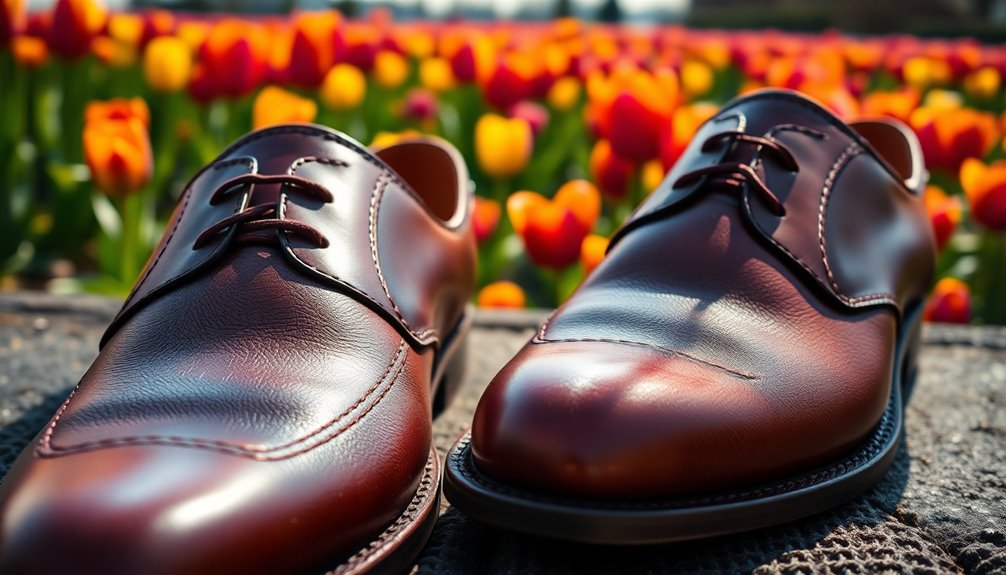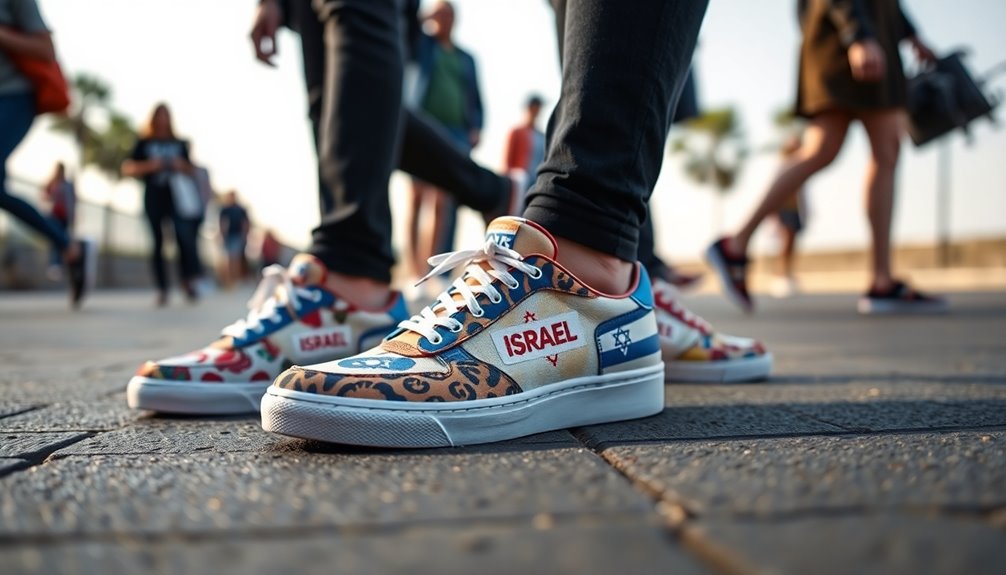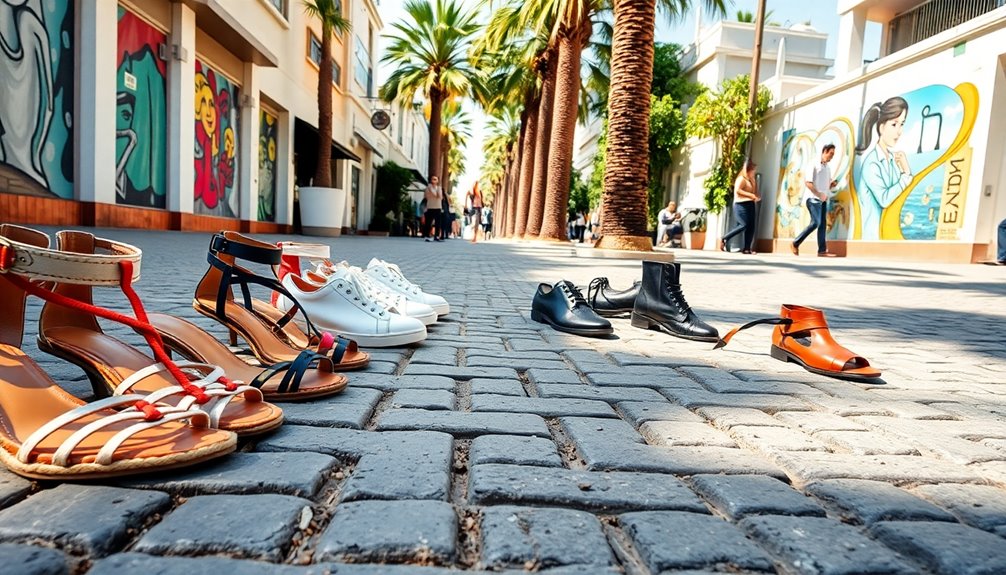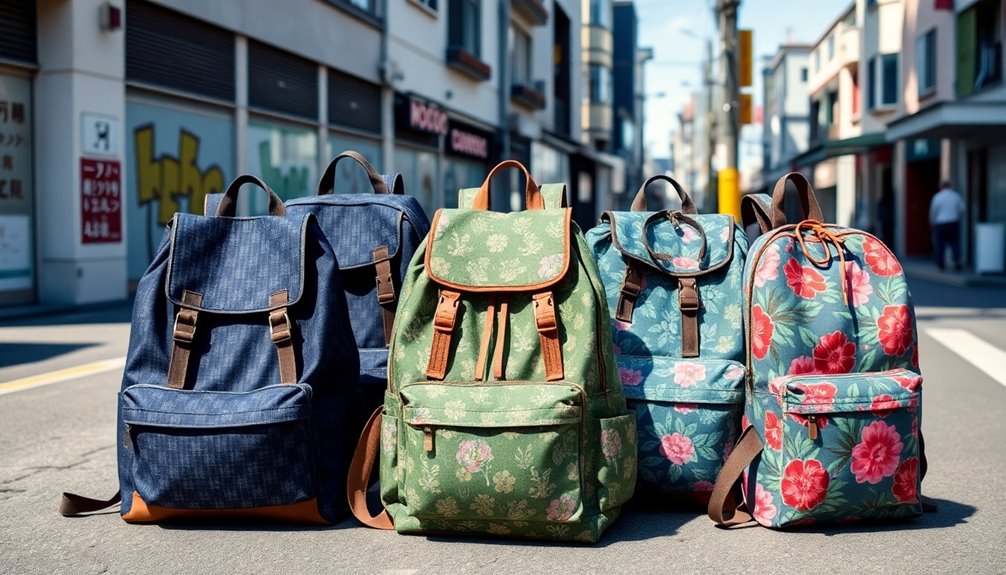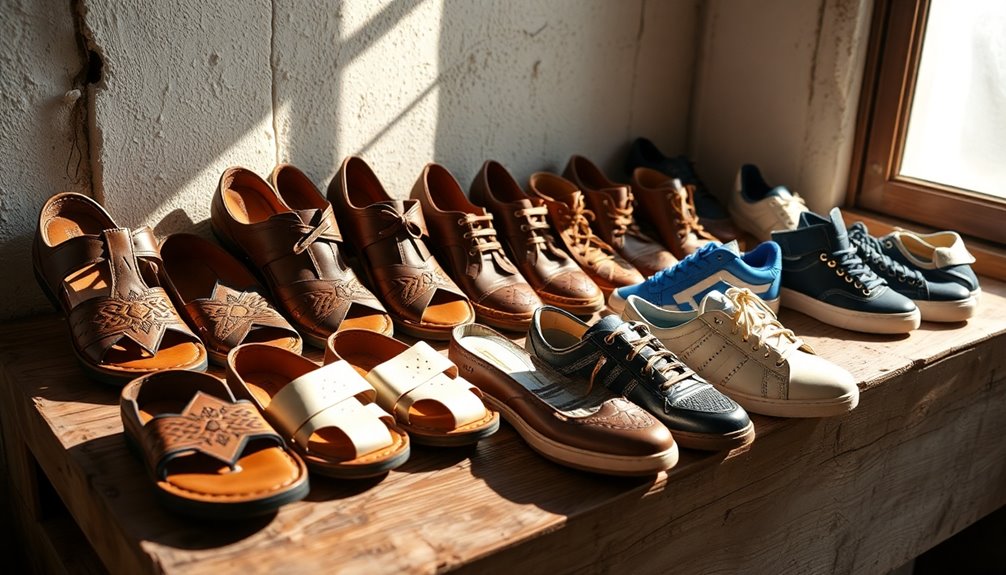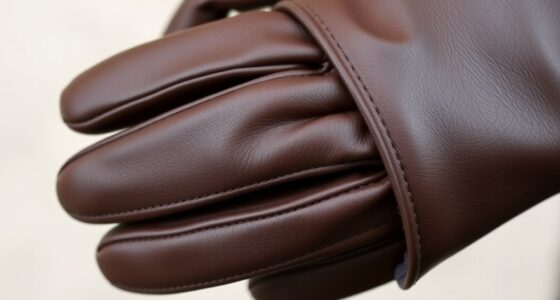When exploring Dutch shoes, you'll find a fascinating mix of tradition and innovation. Iconic brands like Floris van Bommel and Fred de la Bretoniere emphasize quality craftsmanship and stylish designs. You'll love the unique offerings from Nubikk and ETQ Amsterdam, featuring trendy sneakers perfect for any occasion. Don't forget about the classic wooden clogs that have been crafted since the 13th century, showcasing the Netherlands' rich heritage. Many brands focus on sustainable materials, ensuring you look good while being environmentally conscious. If you're curious about the latest trends and styles, there's plenty more to discover!
Key Takeaways
- Prominent Dutch shoe brands include Floris van Bommel, known for craftsmanship, and Fred de la Bretoniere, focusing on women's footwear.
- Nubikk offers luxury sneakers targeting young adults, while ETQ Amsterdam provides stylish, minimalist sneaker designs at affordable prices.
- Dutch clogs, crafted from lightweight willow, combine durability with cultural heritage, making them ideal for gardening and farming.
- Many brands emphasize sustainability, using eco-friendly materials and ethical production practices to minimize environmental impact.
- Online platforms and specialty boutiques showcase unique styles, reflecting Dutch craftsmanship and offering a range of prices from €98 to €220.
Overview of Dutch Footwear
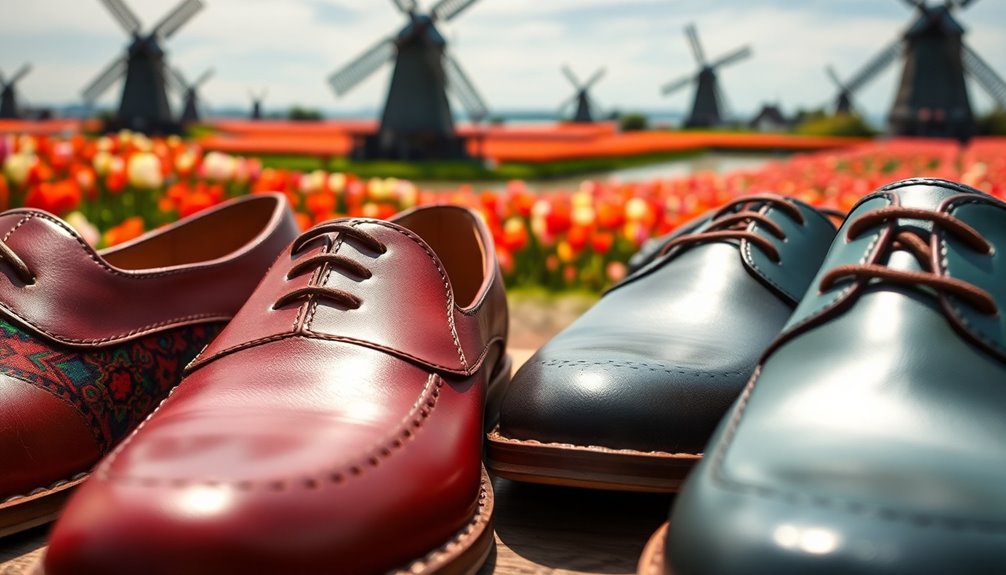
Dutch footwear is a vibrant blend of tradition and modernity, showcasing a rich variety of styles that cater to diverse tastes. When you explore Dutch shoes, you'll find everything from iconic wooden clogs, steeped in cultural significance, to sleek, contemporary sneakers that reflect today's fashion trends. Renowned brands like Floris van Bommel, Fred de la Bretoniere, and Nubikk exemplify the unique craftsmanship that Dutch footwear offers.
Many Dutch shoe brands prioritize sustainability, using eco-friendly materials and ethical production methods in their designs. This commitment not only elevates the quality of Dutch shoes but also aligns with a growing consumer demand for responsible fashion.
The average price for casual styles typically ranges between €98 and €220, and you'll often find promotions that make these stylish options more accessible.
What sets Dutch shoes apart is their ergonomic design, ensuring comfort and durability for everyday wear. You won't just look good; you'll feel good too.
Whether you're dressing up or keeping it casual, Dutch footwear provides a perfect blend of style and practicality that fits seamlessly into your life.
Iconic Dutch Shoe Brands
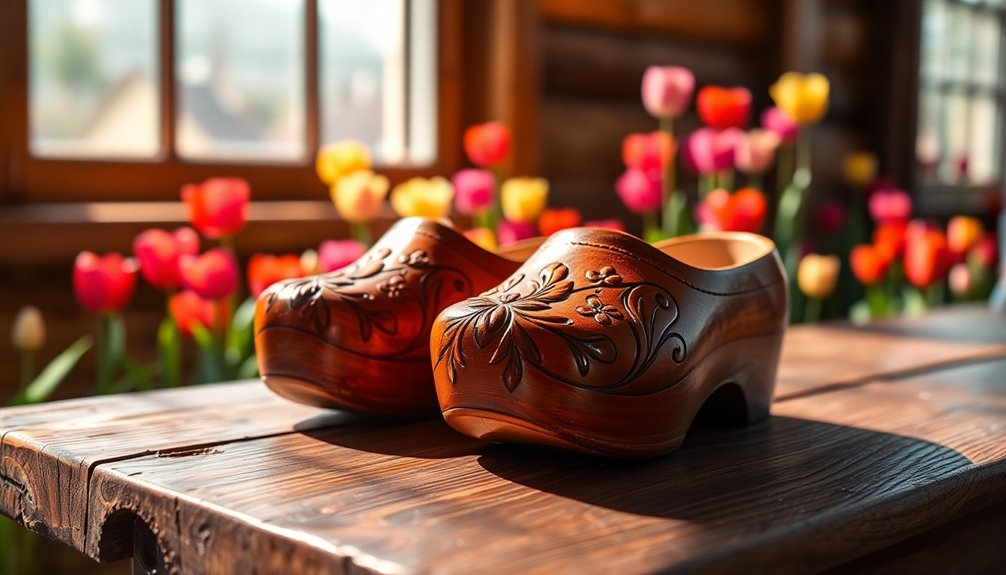
When it comes to iconic footwear, several brands stand out in the Netherlands, each with its unique identity and style. One of the most renowned is Floris van Bommel, boasting over 280 years of history. Known for its high-quality craftsmanship, this brand offers luxurious options, including casual sneakers that blend tradition with modernity.
Fred de la Bretoniere, established in 1970, is celebrated for its strong designs that cater to women's footwear needs, emphasizing quality materials.
Meanwhile, VIA VAI captures the youthful spirit with trendy sandals, sneakers, and ankle boots perfect for a diverse audience.
If you're into luxury and comfort, Nubikk is a brand you shouldn't overlook. Their sneakers are designed for young adults who appreciate distinct style and high-quality materials.
Finally, ETQ Amsterdam stands out with its minimalist sneaker designs, offering stylish yet affordable options that resonate with those seeking simplicity in Dutch sneaker culture.
While these brands may not focus on Dutch clogs, they each contribute to a rich narrative of Dutch footwear, showcasing the innovation and quality that the Netherlands is known for.
History of Wooden Shoes
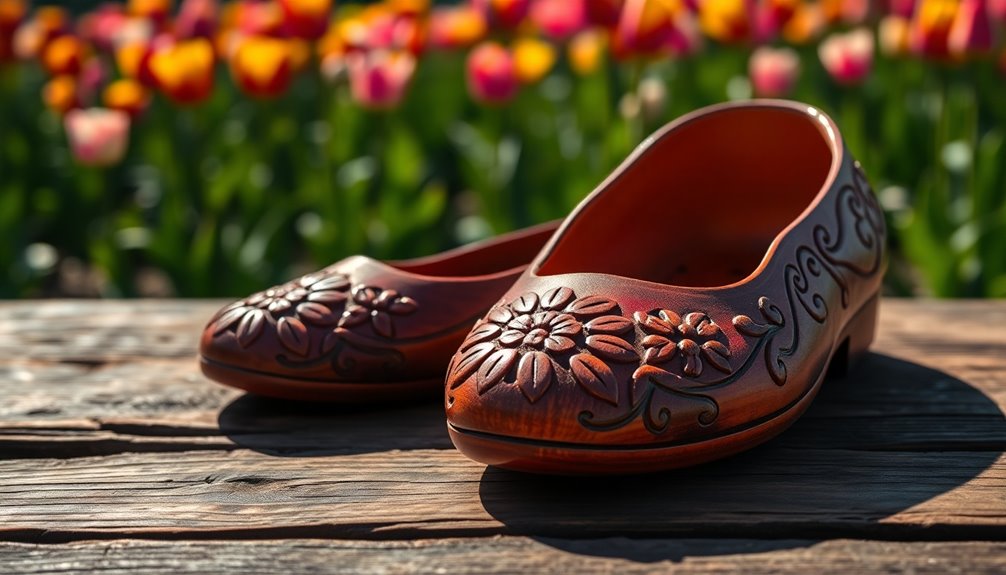
You might be surprised to learn that wooden shoes have evolved considerably since their first appearance in the Netherlands around 1230.
Initially crafted for practicality, these clogs reflect the cultural importance of Dutch craftsmanship, with designs varying by region and tradition.
Today, they're not just functional footwear; they symbolize a rich heritage that continues to inspire both artisans and tourists alike.
Evolution of Clog Designs
The evolution of clog designs reveals a fascinating journey through craftsmanship and cultural identity. Since the first Dutch clogs emerged around 1230, they've transformed considerably while remaining true to their roots. Originally crafted from a single piece of wood, these wooden shoes are still known for their affordability, durability, and functionality, particularly in the wet Dutch climate.
As you explore the evolution, you'll notice various designs tailored for specific uses. Here's a quick overview:
| Clog Type | Purpose | Design Features |
|---|---|---|
| Farm Clogs | Agricultural work | Sturdy construction, wide fit |
| Gardening Clogs | Outdoor activities | Lightweight, easy to clean |
| Souvenir Clogs | Tourism keepsakes | Colorful patterns, decorative |
| Artisan Clogs | Handcrafted art | Unique designs, cultural motifs |
Clog-making techniques have shifted from traditional handcrafting to machine production, yet some artisans still uphold the old methods today. This evolution reflects the artistry of the maker, showcasing regional traditions and the enduring charm of Dutch wooden shoes.
Cultural Importance of Clogs
Clogs, or klompen, sit at the heart of Dutch culture, embodying both practicality and tradition. Since their first documented use in 1230, these wooden clogs have served as essential footwear for farmers, designed to protect feet from the wet and muddy conditions of the Netherlands.
Traditionally crafted from a single piece of wood, they're water-resistant and durable, making them perfect for rural life.
The craftsmanship of wooden clog making is an art form passed down through generations. Each artisan often has a unique design, reflecting their personal artistry and local culture.
Beyond their functionality, clogs hold cultural significance, representing regional traditions and being featured in various festivals across the country.
Today, you'll find wooden clogs celebrated as popular souvenirs for tourists, serving as a tangible connection to the historical and cultural heritage of the Dutch people.
When you wear or display a pair of clogs, you're not just enjoying a comfortable shoe; you're embracing centuries of tradition and a symbol of the Netherlands that continues to resonate with both locals and visitors alike.
Craftsmanship in Clog Making
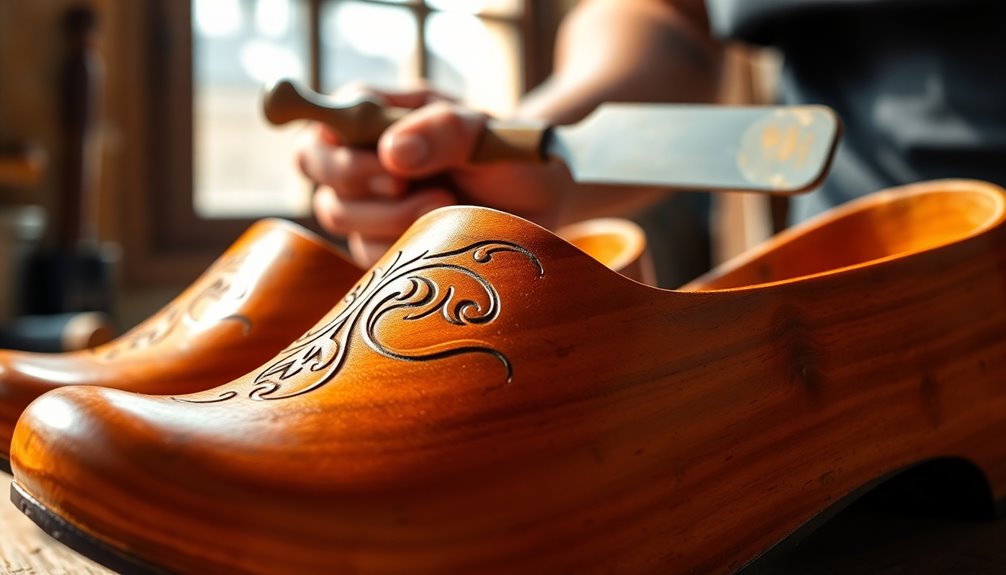
When you think about clog making, consider the traditional techniques and tools that artisans use to create these iconic shoes.
Each artisan brings their unique design to life, reflecting both personal creativity and regional traditions.
This craftsmanship not only highlights the artistry involved but also connects you to the rich cultural heritage of the Netherlands.
Traditional Techniques and Tools
Crafting traditional Dutch clogs is a fascinating art, rooted in time-honored techniques and tools that bring each unique pair to life. Clog makers begin by selecting a single piece of durable willow wood, then soak it to soften the fibers, making it easier to carve. Using a hatchet, carving knife, and gouge, they shape the wood into various designs that reflect both functionality and artistic flair.
Here's a glimpse into the tools and techniques used:
| Tool | Purpose |
|---|---|
| Hatchet | Initial shaping of the wood |
| Carving Knife | Detailed carving and refining the design |
| Gouge | Hollowing out areas for comfort |
| Soaking Technique | Softening wood for easier manipulation |
| Hand Finishing | Finalizing edges for a polished look |
While modern methods have shifted towards mass production, dedicated workshops like the Kooijman Wooden Shoe Workshop continue to embrace these traditional practices. They attract over a million visitors annually, enthusiastic to witness the craftsmanship that defines Dutch clog making. Each pair tells a story, connecting you to the rich heritage of the Netherlands.
Unique Artisan Designs
Discover how unique artisan designs elevate Dutch clogs beyond mere footwear into wearable art. In the Netherlands, traditional clog making has seen a fascinating evolution, blending handcrafting techniques with modern production methods.
However, a handful of artisans still uphold the age-old craft, creating stunning clogs that reflect their personal artistry and regional heritage.
At the Kooijman Wooden Shoe Workshop in Zaanse Schans, thousands flock each year to witness the intricate process of clog making. Here, you'll see how each clog is meticulously carved from a single piece of wood, showcasing the artisan's creativity and skill.
The design isn't just about aesthetics; these clogs are built for comfort and protection, making them both functional and beautiful.
As you explore the craftsmanship behind each pair, you'll appreciate how these wooden shoes embody the cultural heritage of the Netherlands. They serve as perfect souvenirs for tourists, offering a glimpse into the rich history and artistry of Dutch footwear.
In every clog, there's a story waiting to be discovered, reminding you of the enduring value of traditional artisan skills in today's world.
Cultural Heritage and Significance
With a history spanning nearly 800 years, the artistry behind Dutch clog making is a tribute to the nation's cultural heritage. The first wooden clogs appeared around 1230, showcasing a tradition that's remained largely unchanged. Traditionally handcrafted from a single piece of wood, these clogs aren't just durable; they're also water-resistant, making them perfect for the Netherlands' wet climate.
When you explore the significance of clogs, you'll find three key aspects:
- Functional Use: Clogs provide essential protection for farmers, enabling them to work comfortably in muddy conditions.
- Cultural Symbolism: They embody rural life, representing the resilience and creativity of the Dutch people.
- Artistry and Design: Each pair reflects the craftsmanship of its creator, with various styles tailored for gardening, farming, or special occasions.
Visiting workshops like the Kooijman Wooden Shoe Workshop in Zaanse Schans, you can witness this craftsmanship firsthand.
With over a million visitors each year, it's a fantastic way to appreciate the enduring legacy of clogs in Dutch culture.
Features of Dutch Clogs
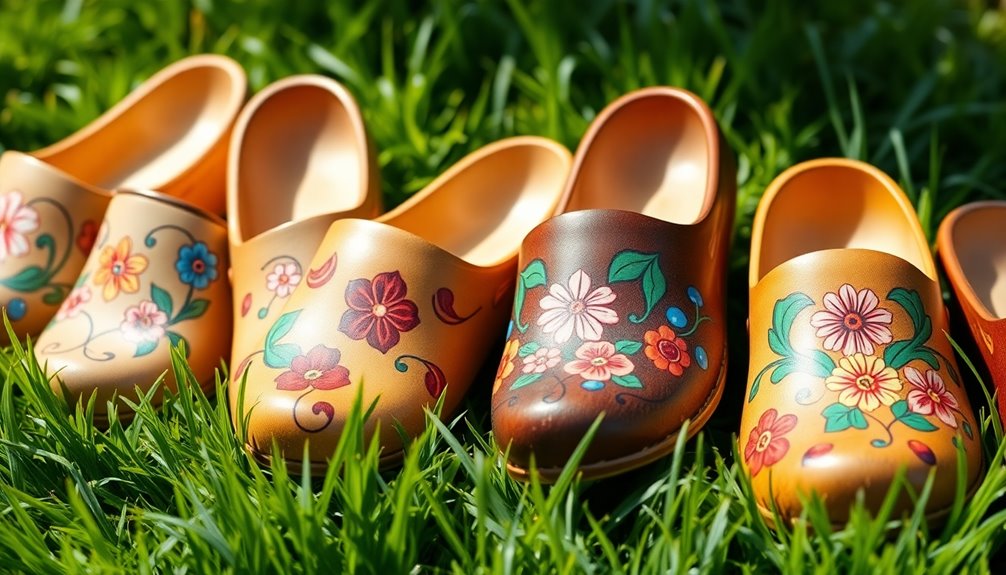
Dutch clogs, or klompen, are frequently celebrated for their unique blend of functionality and artistry. Traditionally crafted from a single piece of wood, primarily willow, these wooden shoes are lightweight yet durable, making them an ideal choice for various activities.
You'll find that clogs come in multiple designs tailored to specific purposes, such as gardening, fishing, and farming, showcasing their practicality.
One of the standout features of Dutch clogs is their natural water resistance, providing comfort and warmth in the often wet Dutch climate. This quality has made them essential footwear for agricultural workers throughout history.
When shopping for wooden shoes, keep in mind that sizes typically range from 29 to 39, and it's recommended to purchase one size larger to allow for heavy socks and comfort.
However, while they offer many benefits, clogs may not be the best option for extended walking or standing due to potential discomfort.
Popular Styles and Trends
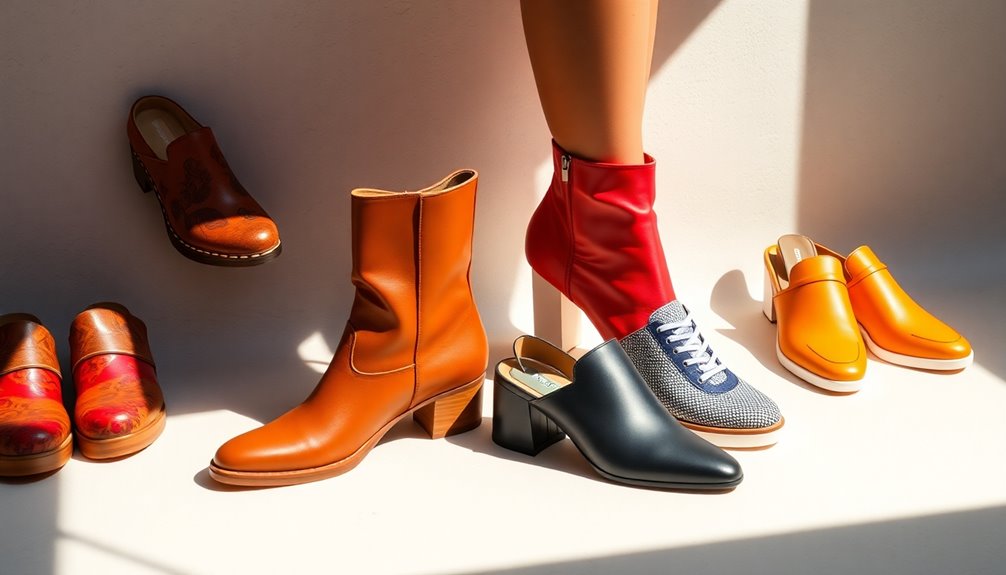
Among the many footwear options, Dutch brands are making waves with their diverse styles and trends that cater to various tastes. From traditional craftsmanship to modern aesthetics, there's something for everyone.
Here are three popular styles you should consider:
- Classic Elegance: Brands like Floris van Bommel and Fred de la Bretoniere focus on high-quality craftsmanship and timeless designs. Their shoes are staples in both men's and women's wardrobes, perfect for any formal occasion.
- Contemporary Sneakers: Nubikk and ETQ Amsterdam lead the charge in modern sneaker trends. They emphasize luxury materials and minimalistic designs, appealing to younger generations who value both style and comfort.
- Trendy Casuals: VIA VAI has gained popularity with its stylish sandals, sneakers, and ankle boots. Their designs embody contemporary Dutch fashion, making them a go-to choice for anyone looking to add a youthful vibe to their shoe collection.
Additionally, the enduring charm of klompen, or wooden shoes, showcases a blend of practicality and cultural heritage.
With seasonal collections and limited-edition releases, Dutch footwear brands continuously innovate to stay ahead of the trends.
Sustainable Footwear Practices
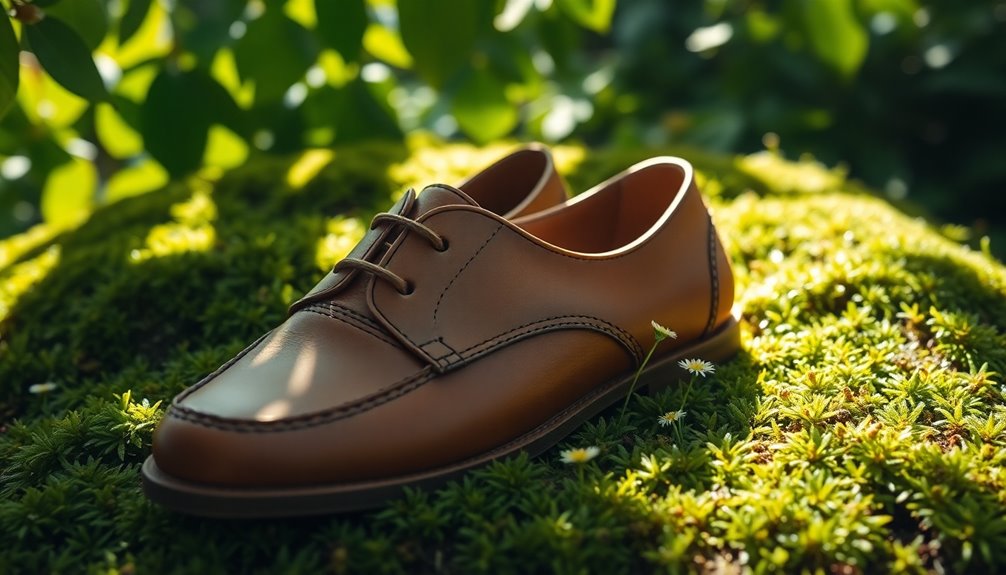
Sustainably focused, many shoe brands are redefining the way we think about footwear by prioritizing ethical practices and eco-friendly materials. Brands like those from the Klijsen family control the entire production process, guaranteeing high-quality leathers free from harmful chemicals such as PCP and benzidine.
By emphasizing sustainable footwear practices, they minimize environmental impact while crafting durable products. These manufacturers embrace slow fashion principles, producing limited quantities that guarantee longevity and reduce waste.
You'll find that the designs often incorporate natural materials like nubuck and smooth leather, which not only enhance sustainability but also guarantee comfort, especially in popular flat shoes.
Additionally, Dutch shoe brands encourage responsible consumerism by offering promotional discounts to minimize overproduction. Their ergonomic designs focus on user comfort, seamlessly blending style and sustainability.
With eco-friendly production practices at the forefront, you can feel good about your choices while enjoying the best of Dutch shoes. By choosing these brands, you're supporting a movement that values both the environment and ethical craftsmanship, making every step you take a mindful one.
Shopping for Dutch Shoes
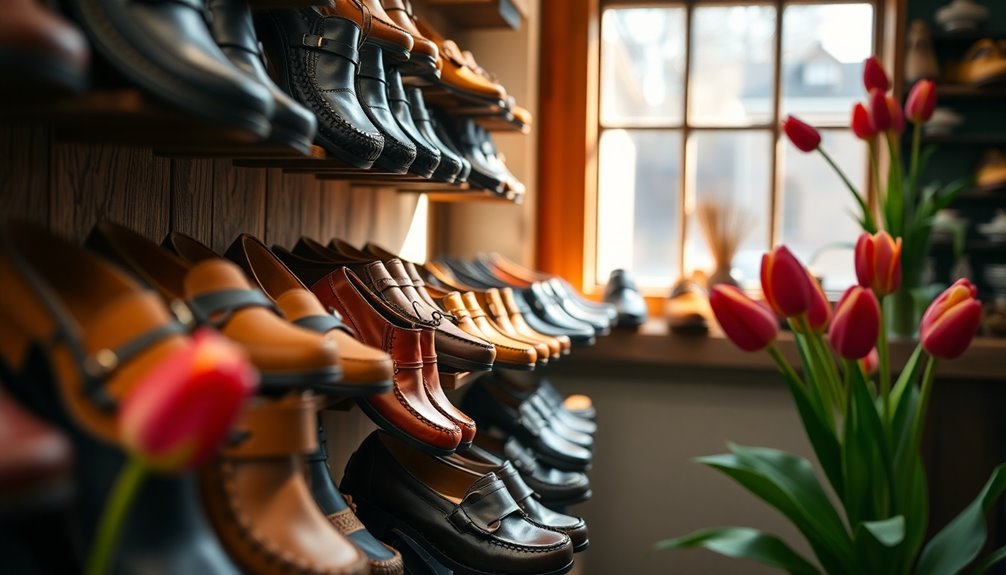
If you're on the hunt for stylish yet environmentally conscious footwear, search no more than the diverse offerings from the Netherlands.
With a rich history of craftsmanship, Dutch brands like Floris van Bommel and ETQ Amsterdam provide an array of options, from elegant boots to traditional wooden clogs.
When shopping for Dutch shoes, consider these essential tips:
- Explore Online Platforms: Websites often feature the latest collections and discounts, making it easy to find quality footwear within €98 to €220.
- Visit Specialty Boutiques: Discover unique styles that reflect Dutch culture and craftsmanship, ensuring you get a personalized shopping experience.
- Check Tourist Areas: Don't miss out on traditional wooden shoes, perfect as souvenirs or a quirky addition to your wardrobe.
Many Dutch shoe brands prioritize ethical practices, ensuring your purchase supports sustainable materials and environmentally friendly production.
With this commitment to quality and style, you can confidently step out in your Dutch boots, knowing they're made with care.
Upcoming Events and Exhibitions
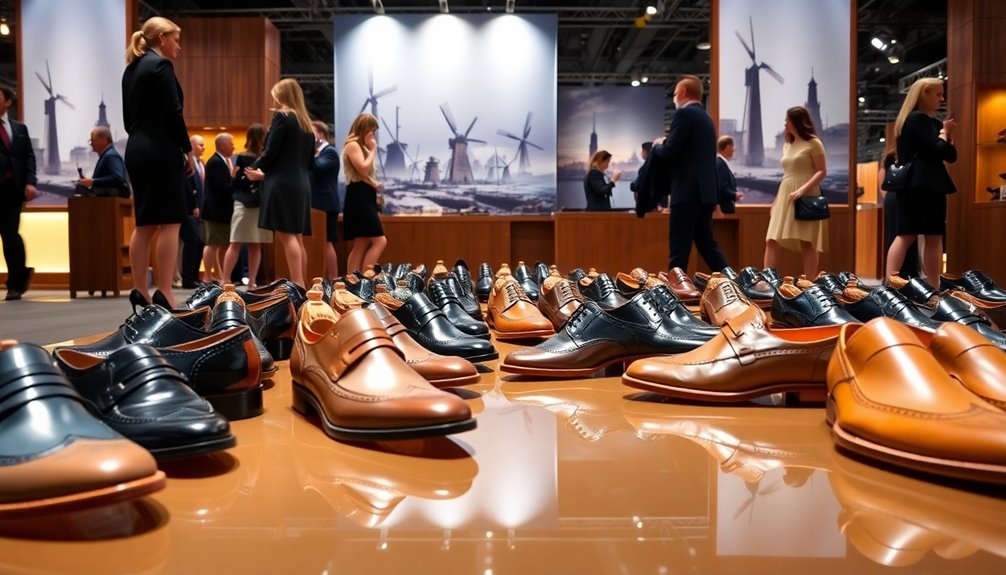
As you discover the unique styles of Dutch shoes, keep an eye out for exciting upcoming events and exhibitions that celebrate this fascinating footwear culture.
On February 28, 2024, the gala edition of Klompenrock will highlight the cultural significance of clogs, offering a lively atmosphere filled with music and art dedicated to traditional Dutch footwear. This is a perfect opportunity to connect with fellow enthusiasts and explore the artistry behind clogs.
Later, mark your calendar for June 12, 2024, when an exhibition featuring artist Willem Witse's stunning clogs will showcase the artistic side of these iconic shoes. You'll get to see how traditional designs can transform into contemporary works of art.
Throughout the year, Dutch-Clogs.com will celebrate its 10th anniversary with various events and promotions, ensuring you stay engaged with the latest trends in Dutch footwear, including stylish ankle boots.
Recent product reviews emphasize customer satisfaction, reinforcing the popularity and quality of Dutch shoe brands. Stay tuned for continuous updates on new products and events, so you won't miss any opportunity to elevate your footwear collection!
Frequently Asked Questions
What Is the Famous Shoe in the Netherlands?
The famous shoe in the Netherlands is the wooden clog, or "klomp."
These unique shoes have a rich history, dating back to at least 1230. Originally designed for farmers, they protect your feet and keep them dry in wet conditions.
While you might see them as souvenirs today, they still hold cultural significance. If you visit places like Zaanse Schans, you can watch artisans craft these iconic shoes and appreciate their heritage.
What Is the Name of the Traditional Shoes From Netherlands?
Imagine walking through a vibrant landscape, where wooden shoes echo stories of a rich culture.
The traditional shoes from the Netherlands are called "klompen." These wooden marvels, often crafted from willow, have been worn for centuries, protecting feet from the muddy fields.
They're not just functional; they symbolize Dutch heritage. You'll find both plain styles for farmers and beautifully decorated versions for tourists, each step resonating with history and craftsmanship.
Are Dutch Clogs Good for Your Feet?
Yes, Dutch clogs can be good for your feet when worn correctly. Their ergonomic design promotes a natural foot position, which may improve overall foot health.
The wooden construction offers shock absorption, reducing fatigue during extended use. Plus, the ventilation keeps your feet dry and comfortable.
If you wear them with heavy wool socks, you'll enhance cushioning and comfort, making long periods of wear more enjoyable while protecting your feet.
Why Are Shoes Famous in the Netherlands?
Shoes are famous in the Netherlands due to their rich cultural history and craftsmanship.
You'll find that traditional wooden clogs, or klompen, have been around since the 13th century, showcasing Dutch ingenuity.
Modern brands have embraced this legacy, focusing on sustainability and style, which attracts diverse audiences.
Plus, festivals celebrating this footwear heritage further cement their importance in Dutch identity, making them a symbol of both tradition and contemporary fashion.
Conclusion
So, whether you're strutting in clogs or slipping into sleek Dutch designs, remember that footwear from the Netherlands isn't just about keeping your feet comfy; it's about making a fashion statement that says, "I may be practical, but I'm fabulously quirky!" Who needs boring shoes when you can channel your inner windmill? Embrace the craftsmanship and sustainability of Dutch footwear—because nothing screams "trendy" quite like a shoe that originated from a potato farmer's workshop!
